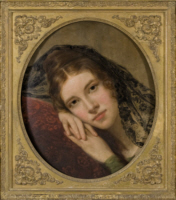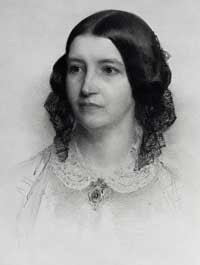Frances Elizabeth Appleton Longfellow was known as “Fanny” since the day of her birth, October 6, 1817. Fanny was the youngest of four children born in Boston to Nathan and Maria Appleton. Nathan became wealthy as one of the owners of a textile factory in Waltham, MA and was eventually elected as a Representative to Congress.
After his wife’s death in 1833, he proposed to his children a North American “grand tour” to Trenton Falls, Niagara Falls, and the White Mountains of New Hampshire. Fanny acquired a sketchbook in Utica, NY which she used to record her remembrances of her two-month journey. In this sketchbook, Fanny recorded two of the earliest known artistic images of the Old Man. Although said to have been discovered in 1805 during road work, this unique rock formation does not seem to have inspired artists until the late 1820s when tourism was beginning to flourish in the region. It was not until 1837 that the first painting of the Old Man was exhibited at the Boston Athenaeum by another Bostonian, Catherine Scollay.
Returning to Boston from Franconia Notch, Fanny sketched a view of Centre Harbour on Lake Winnipiseogee [sic]. In total, Fanny made forth-eight drawings as souvenirs for herself and her family of their excursion.
Three years later in Switzerland during the family’s European grand tour, Fanny Appleton met poet Henry Wadsworth Longfellow. Back in Boston, he courted her for seven years before they were married. After her marriage, Fanny’s drawing activities came to an abrupt halt.
Upper Portrait Credit
Courtesy of the National Park Service, Longfellow National Historic Site
Reference
Korzenik, Diana. Face to Face: Fanny Appleton and the Old Man of the Mountain, Historical New Hampshire, Vol. 63, No. 2, Fall 2009, pp. 120-139.

